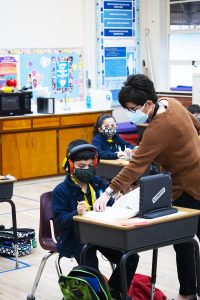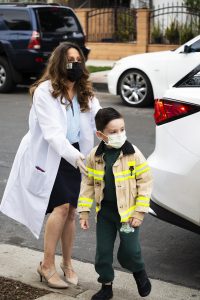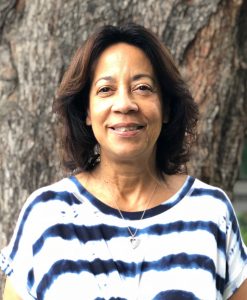All things considered, Debbie Marquez didn’t realize how much she missed certain sounds.
“The giggles and the laughter. Goodness, it is so nice to hear that joy in the hallways.”
They are sounds that Marquez can once again enjoy at Holy Name of Mary School in San Dimas, where she is principal. For almost a year, her school’s nearly 350 enrolled students were kept home by the COVID-19 pandemic.
“It was so quiet and empty without them here and, really, it was sad to come to work. It just didn’t feel right.”
Now, hers is one of the more than 60 schools in the tri-county Archdiocese of Los Angeles that have been allowed to reopen for in-class instruction so far. As health officials begin to loosen requirements for reopening, more schools like Holy Name of Mary are expected to rediscover the sights and sounds of normalcy this semester.
Or at the least a COVID-19-approved version of it.

For the first half of the 2020-21 school year, the state set up a waiver system by which schools would apply to reopen, depending on virus case rates and the colored tier rankings they help determine. Those who cleared the process by the Department of Public Health could bring rotations of students in transitional kindergarten (TK) through second grades.
Allowances had also been made for students K through eighth grade experiencing difficulty with distance learning, as they could attend class in person as part of modified smaller cohort groups.
In January, the state discontinued the waiver system and made it simple: When a county drops below 25 COVID-19 cases per 100,000 residents, schools will be allowed to bring back TK through sixth grade. As of Feb. 16, the rate in both Los Angeles had dropped below 25, with Santa Barbara and Ventura counties not far behind.
“Every week we have more and more schools opening, bringing students back in different cohorts, and we are hopeful if the numbers keep dropping, schools that aren’t open yet will see a clear path and can prepare for reopening within weeks,” said Ryan Halverson, the Department of Catholic Schools assistant superintendent.
For a variety of reasons, reopening classrooms has proven easier for private schools than public ones until now. But at a time when the federal government is seeking to convince reluctant schools that in-person schooling can be conducted safely, and LA County has officially cleared elementary school campuses to fully reopen, the reopening struggles and successes of LA’s Catholic schools may hold some valuable lessons for the rest of the region.

At schools around the archdiocese, students are returning to a learning experience different from the one they last saw in March 2020.
Desks in classrooms are separated by at least six feet of distance, some encased in Plexiglas. Face coverings are the newest additions to the school uniform. Teachers are usually in the classroom, but not always. In some cases, they give class remotely, with in-person aides — sometimes including the school principal — helping students follow along with classmates shown on screens learning remotely.
Paul Escala, superintendent of Catholic schools for the archdiocese, knows firsthand as a parent what that means.
Both of his sons attend St. Joseph’s School in Long Beach, which was granted a waiver. His kindergartner is back to going full days. His third-grader is in the classroom twice a week as part of one of those high-need cohorts, learning and doing school work in a class with 12 others on their iPads.
The reopening application system, the arrival of COVID-19 vaccines, and the efforts of school staff to make classrooms safe all give Escala cause for optimism. But sometimes overlooked, he says, is the support coming from outside the classrooms.
“Parents are finding their voice amidst the noise that’s out there, holding leaders and elected officials accountable to figure this out,” said Escala. “That level of advocacy and urgency is very promising. Schools can’t do it alone. We need parents more than ever to be with us and partners in not doing this alone.”

It helps that the success stories Escala has seen in his own district are part of a nationwide trend: Around the U.S., Catholic schools are showing the country how to “keep classrooms open while keeping COVID-19 at bay,” wrote Wall Street Journal columnist William McGurn, who declared that “Catholic Schools Are Beating Covid” in a Feb. 1 op-ed.
McGurn praised Catholic school administrators around the country who “have moved heaven and earth to keep their classrooms open,” even amid a national enrollment drop of 6.4% for Catholic schools since COVID-19 started.
The article also pointed out that as the nation’s largest Catholic school system, and 78% of its 70,000 students being children of color, Los Angeles has faced the added challenge of the disproportionate toll COVID-19 rate has taken on minority families, especially in inner-city areas.
In LA and around the country, a big reason Catholic schools have been more nimble in reopening is that so many of their teachers have been eager to do so.
At St. Paul the Apostle School in Westwood, principal Crystal Pinkofsky said the hard work of teachers since last summer laid the foundation for the school’s first waiver approval and reopening in August.
“It took very hard work and the dedication by the entire staff, many giving up their summer, to have our plan implemented,” said Pinkofsky, who had to close the school for several weeks when COVID-19 cases spiked last November. “Our reopen has been smooth, but to get grades three-six back with the next tier, that’s the roller-coaster ride we’ve also been on.”

St. Paul has been back open since Feb. 1 for TK through second grade, with hybrid options available in cohorts as well. Almost half of the 558 enrolled students are now able to come back to a school with some 45 teachers. The next challenge, Pinkofsky said, will be getting grades three-six back, hopefully in the coming weeks.
At St. Madeleine School in Pomona, where total enrollment is 35 students for pre-K through fifth grade, principal Maria Jimenez said months ago they had already painted angels and crosses on the sidewalk to visualize distancing. Now she can enjoy watching “my little people” bound from symbol to symbol as if it was a game of hopscotch.
“A Catholic school really isn’t a Catholic school without the children present,” said Jimenez, who also teaches a kindergarten grammar class. “I knew if we kept waiting for the ‘perfect time’ to reopen, there would never be a perfect time. We have all the mandates in place, the smart documents are there, parents can come on campus and see and have a level of comfort so when the time came, there were zero questions.”
Ashley Hobbs, the principal at Notre Dame Academy in LA, where 66 of the 288 enrolled students have returned to campus since Feb. 1, said she continues to tell parents during regular meetings that there are four words defining the collaboration in getting this school back open: innovation, patience, flexibility, and grace.
“Flexibility is huge, but it starts with a growth mindset going in that we’ve talked about for years, and now it is the opportunity to live it,” said Hobbs.
“As a principal, it’s also easy to want to control everything, and you can’t,” Hobbs explained in a phone interview with Angelus. “It has to be a team, and this year, bringing parents into that team more than ever has been vital. You can never make everyone happy, but it is about being transparent.”
At St. Ferdinand School in San Fernando, principal Luis Gamarra saw enrollment drop from 189 to about 100 over the last couple of years, with the latest blow coming as a result of COVID-19-related financial pressures on families.
He saw a short burst of 10 students return in December, but when one of them tested positive for COVID-19, things shut down and have been since. They target March to bring back at least two cohorts and at least a quarter of the students.
“Personally, I’ll be ecstatic when that happens, because none of us like being cooped up,” said Gamarra. “As much as I miss them, I can only imagine how much they miss their friends and all those things that make learning fun. Learning face-to-face in person, that makes us a family.”

Holy Name of Mary principal Marquez pointed out that the state’s waiver system was “really intended to help those most in need, but it never did that, because most of them have the highest COVID-19 rates in their communities and couldn’t qualify. There is an issue of inequity in our demographics.”
She finds comfort in that the time of her students’ return to the classroom coincides with the start of Lent. The parish’s annual Lenten theme this year is “Out of the Dust,” a line borrowed from the Grammy-winning gospel song, “Beautiful Things.”
“It’s so appropriate for where we are right now — we have this dust and dirt in our lives but beautiful things are coming,” she said. “We need to start centering people back on who they are and who they want to be. If you just focus on COVID, it can overwhelm you.”
Father Celso Marquez at Our Lady of Guadalupe Church in Oxnard is himself coming off a bout with COVID-19 that sent his parish rectory into quarantine and canceled Christmas services. Fallout from the stresses brought on by the struggles of remote learning led to the loss of several school staff members.
“We are doing all we can do, but we can’t do miracles — those only come from God,” said Father Marquez, currently functioning as the acting principal and parish administrator at Our Lady of Guadalupe, whose 115-year-old school has about 90 students enrolled.
“The founders of the school, the Missionaries of the Holy Spirit, have said that you ‘Do your best and God will do the rest.’ That is still our motto.”

